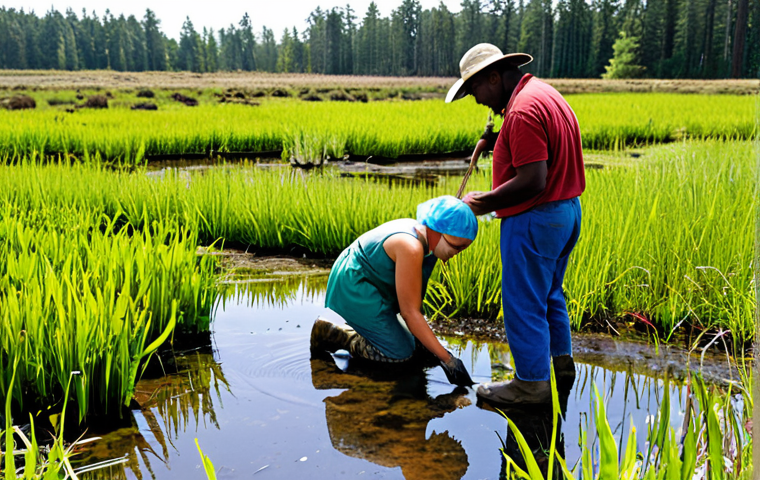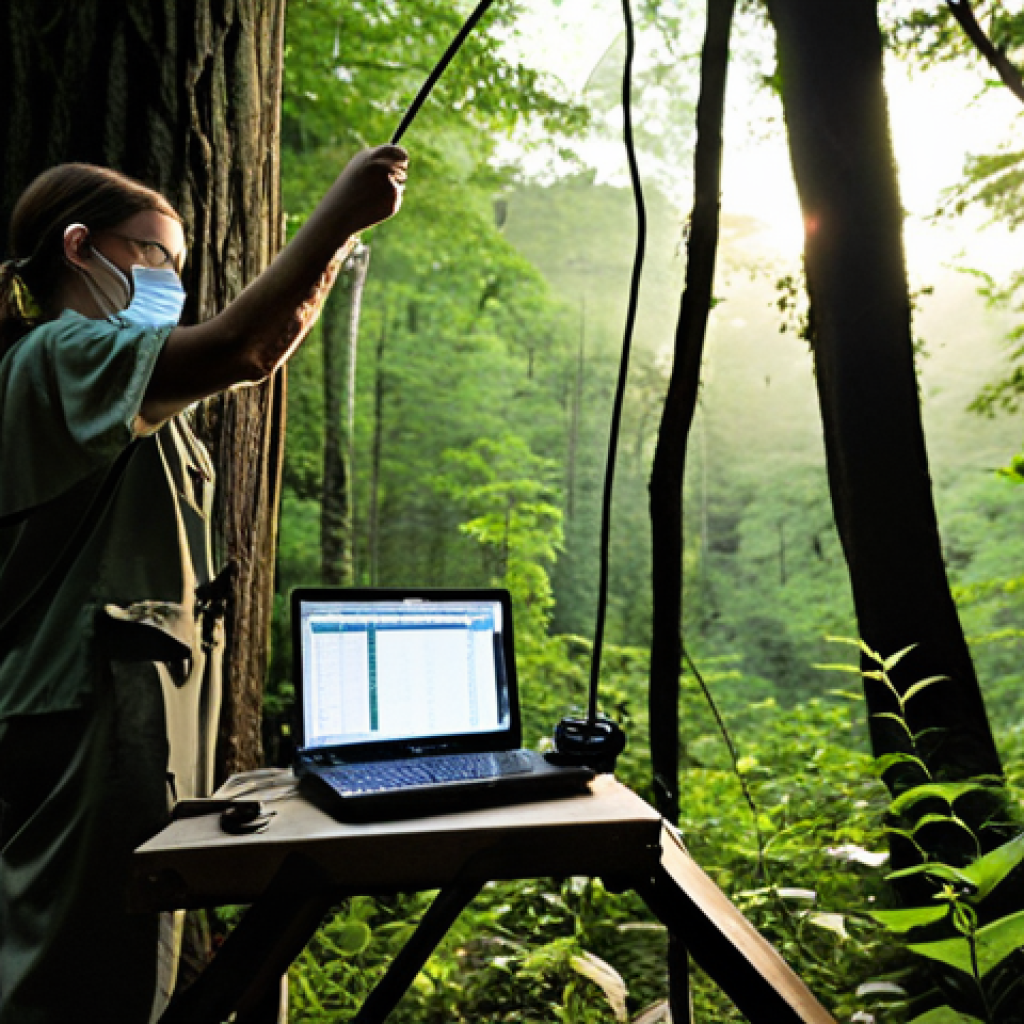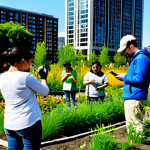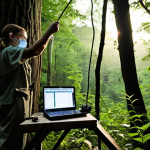Have you ever gazed out at the vast tapestry of nature and felt a deep connection, a calling to protect its intricate beauty? I have. The sheer diversity of life on our planet, from the tiniest microorganisms to the majestic whales, is simply awe-inspiring.
But this incredible biodiversity is under threat, and that’s where biodiversity conservation experts come in – the guardians of our planet’s natural heritage.
It’s a field that’s not just about science; it’s about passion, dedication, and a commitment to securing a sustainable future. Personally, I’ve always felt drawn to this field, especially seeing how emerging technologies like AI and drone monitoring are revolutionizing conservation efforts.
Seeing firsthand how these innovations can help protect endangered species is truly inspiring. Let’s dive into the details and discover more about this vital career path below.
Understanding the Core Roles of a Biodiversity Conservation Expert

1. Research and Data Collection
One of the foundational aspects of this field is rigorous research. As someone who spent a summer assisting with bat population studies in the Appalachian Mountains, I can tell you firsthand that data collection is no walk in the park. It involves everything from trekking through dense forests at dawn to meticulously analyzing samples in a lab. Biodiversity conservation experts often design and implement studies to assess the health and diversity of ecosystems. They collect data on species populations, habitat conditions, and the impacts of environmental stressors. This data then informs conservation strategies and policies. I remember one particularly challenging night when our team was trying to capture bats for tagging – the bats were not cooperating! But that experience taught me the importance of patience and precision in scientific research.
2. Conservation Planning and Implementation
Beyond research, these experts develop and implement conservation plans to protect endangered species and their habitats. This might involve creating protected areas, restoring degraded ecosystems, or managing invasive species. I had the opportunity to volunteer with a local organization that was working to restore a wetland area near my hometown. It was incredible to see how removing invasive plants and reintroducing native species could revitalize an entire ecosystem. Conservation planning also requires collaboration with various stakeholders, including government agencies, local communities, and private landowners. I attended several community meetings where the organization presented their plans and addressed concerns from local residents. It was a valuable lesson in the importance of community engagement in conservation efforts.
3. Education and Advocacy
Raising awareness about biodiversity and the importance of conservation is another critical role. Biodiversity conservation experts often engage in public education programs, workshops, and outreach events to inform people about the threats to biodiversity and the actions they can take to help. I once gave a presentation at a local school about the importance of protecting pollinators. The kids were so enthusiastic and asked so many insightful questions! It reinforced my belief that education is key to fostering a sense of stewardship for the environment. Advocacy is also a vital part of the job. Experts advocate for policies that protect biodiversity and promote sustainable practices. This might involve lobbying government officials, participating in public debates, or working with environmental organizations to raise awareness about important issues.
Essential Skills and Qualifications
1. Academic Background
A strong academic foundation is essential for a career in biodiversity conservation. Most positions require at least a bachelor’s degree in a relevant field, such as biology, ecology, environmental science, or conservation biology. Many professionals also pursue advanced degrees, such as a master’s or Ph.D., to specialize in a particular area of conservation. For example, a master’s degree in wildlife management might be ideal for someone interested in working with endangered species, while a Ph.D. in ecology could be beneficial for those interested in conducting research on ecosystem dynamics. I personally know a few experts who have their Ph.D. and they are pioneers in their field of work.
2. Technical Skills
Technical skills are also crucial for success in this field. This includes proficiency in data analysis, geographic information systems (GIS), and other software tools used for mapping and modeling ecological data. GIS skills are particularly valuable for creating maps of habitats, tracking species movements, and assessing the impacts of environmental changes. As someone who has spent countless hours working with GIS software, I can attest to its power in visualizing and analyzing complex ecological data. In addition to software skills, biodiversity conservation experts should also have a solid understanding of ecological principles, such as population dynamics, community ecology, and ecosystem function. They should also be familiar with various conservation techniques, such as habitat restoration, species management, and protected area management.
3. Soft Skills
Beyond technical expertise, soft skills are also important for success in this field. This includes communication skills, teamwork skills, and problem-solving skills. Biodiversity conservation often involves working with diverse groups of people, including scientists, policymakers, local communities, and private landowners. Effective communication is essential for building relationships and fostering collaboration. I remember one project where our team had to work with a group of local farmers to implement conservation practices on their land. It required a lot of patience and diplomacy to address their concerns and build trust. Teamwork is also crucial for tackling complex conservation challenges. Experts often work in interdisciplinary teams, bringing together different perspectives and expertise to develop effective solutions. Problem-solving skills are also essential for addressing the many challenges that arise in conservation, such as habitat loss, climate change, and invasive species.
Navigating the Job Market: Where Biodiversity Conservation Experts Work
1. Government Agencies
Government agencies at the federal, state, and local levels are major employers of biodiversity conservation experts. These agencies are responsible for managing public lands, protecting endangered species, and enforcing environmental regulations. In the United States, agencies such as the U.S. Fish and Wildlife Service, the National Park Service, and the Environmental Protection Agency all employ conservation professionals. These roles can range from field biologists who conduct surveys and monitor wildlife populations to policy analysts who develop and implement conservation strategies. I interned with a state wildlife agency one summer, and I was impressed by the dedication and expertise of the staff. They were all deeply committed to protecting the state’s natural resources.
2. Non-Profit Organizations
Non-profit organizations play a vital role in biodiversity conservation. These organizations work to protect endangered species, conserve habitats, and promote sustainable practices. Some well-known conservation organizations include The Nature Conservancy, the World Wildlife Fund, and the Sierra Club. These organizations employ a wide range of professionals, including scientists, conservation planners, educators, and advocates. I volunteered with a local chapter of The Nature Conservancy, and I was amazed by the impact they were having on protecting local ecosystems. They were able to acquire and manage critical habitats, restore degraded areas, and educate the public about the importance of conservation.
3. Research Institutions and Academia
Research institutions and universities also offer opportunities for biodiversity conservation experts. These institutions conduct research on biodiversity, ecology, and conservation, and they train the next generation of conservation professionals. As someone who has spent time in academia, I can attest to the intellectual excitement and the opportunity to make a real difference through research and teaching. Faculty positions at universities often involve conducting research, teaching courses, and mentoring students. Research positions at institutions such as the Smithsonian Institution and the Woods Hole Oceanographic Institution offer opportunities to conduct cutting-edge research on biodiversity and conservation.
Salary Expectations and Career Advancement
1. Entry-Level Positions
Entry-level positions in biodiversity conservation typically require a bachelor’s degree and may involve fieldwork, data collection, and assisting with research projects. Salaries for entry-level positions vary depending on the employer, location, and specific job duties. According to the U.S. Bureau of Labor Statistics, the median annual salary for conservation scientists and foresters was $64,030 in May 2022. However, entry-level salaries may be lower, especially for positions with non-profit organizations or government agencies in rural areas. I remember when I was first starting out, I had to take a volunteer position to gain experience. It wasn’t glamorous, but it was a valuable learning experience.
2. Mid-Career Positions
Mid-career positions in biodiversity conservation often require a master’s degree and several years of experience. These positions may involve managing conservation projects, developing conservation plans, and supervising staff. Salaries for mid-career positions are typically higher than entry-level salaries, reflecting the increased responsibilities and experience required. A conservation manager with a non-profit organization might earn between $70,000 and $90,000 per year, while a senior scientist with a government agency might earn between $80,000 and $110,000 per year. I’ve seen many professionals in these roles demonstrate exceptional leadership and problem-solving skills.
3. Senior-Level Positions
Senior-level positions in biodiversity conservation typically require a Ph.D. and extensive experience. These positions may involve leading research programs, directing conservation organizations, or advising policymakers. Salaries for senior-level positions are the highest in the field, reflecting the advanced education, experience, and leadership required. A director of a conservation organization might earn over $150,000 per year, while a lead scientist with a government agency might earn over $120,000 per year. These positions often require a strong track record of research, publications, and successful conservation initiatives. I’ve always looked up to leaders in the field who have dedicated their lives to protecting biodiversity.
Tools of the Trade: Technologies Used by Conservation Experts
1. Geographic Information Systems (GIS)
GIS is an indispensable tool for biodiversity conservation experts. It allows them to map and analyze spatial data, such as habitat distributions, species ranges, and land use patterns. GIS can be used to identify areas of high biodiversity value, assess the impacts of environmental changes, and design conservation strategies. As someone who has spent countless hours working with GIS software, I can attest to its power in visualizing and analyzing complex ecological data. I’ve used GIS to map the distribution of endangered species, identify critical habitats, and assess the impacts of climate change on ecosystems. It’s a tool that every conservation professional should be familiar with.
2. Remote Sensing
Remote sensing technologies, such as satellite imagery and aerial photography, provide valuable data for monitoring ecosystems and assessing environmental changes. Remote sensing can be used to track deforestation, monitor water quality, and assess the health of vegetation. Drones are increasingly being used for remote sensing, providing high-resolution imagery at a relatively low cost. I’ve seen firsthand how drones can be used to monitor forest health, track wildlife populations, and assess the impacts of natural disasters. It’s a technology that’s revolutionizing the field of conservation.
3. Data Analysis Software
Data analysis software, such as R and Python, is essential for analyzing ecological data and drawing meaningful conclusions. These tools allow conservation experts to perform statistical analyses, build models, and visualize data. I use R extensively in my work to analyze data on species populations, habitat conditions, and the impacts of environmental stressors. It’s a powerful tool that allows me to extract insights from complex datasets and inform conservation decisions. Conservation experts also use database management systems, such as Microsoft Access and MySQL, to store and manage large datasets. These systems allow them to organize data, track changes over time, and share data with other researchers and stakeholders.
Making a Difference: The Impact of Biodiversity Conservation
1. Protecting Endangered Species
One of the most important contributions of biodiversity conservation is protecting endangered species. Biodiversity conservation experts work to identify and protect critical habitats, manage populations of endangered species, and combat threats such as poaching and habitat loss. I’ve seen firsthand the positive impact of these efforts. For example, the reintroduction of wolves to Yellowstone National Park has helped to restore the park’s ecosystem and improve the health of the elk population. Similarly, efforts to protect sea turtles have helped to increase their populations after decades of decline. It’s incredibly rewarding to know that your work is helping to save species from extinction.
2. Conserving Ecosystems
Biodiversity conservation also plays a vital role in conserving ecosystems. Ecosystems provide a wide range of benefits, including clean air and water, pollination, and climate regulation. By protecting ecosystems, conservation experts help to ensure that these benefits are available for future generations. I’ve worked on projects to restore wetlands, forests, and grasslands. It’s amazing to see how these ecosystems can recover when given the chance. For example, restoring a wetland can improve water quality, reduce flooding, and provide habitat for a variety of species. Conserving ecosystems is not just about protecting wildlife; it’s about protecting the health and well-being of human communities as well.
3. Promoting Sustainable Practices
Biodiversity conservation promotes sustainable practices that benefit both the environment and human communities. This includes promoting sustainable agriculture, forestry, and fisheries. By adopting sustainable practices, we can reduce our impact on the environment and ensure that resources are available for future generations. I’ve worked with farmers to implement sustainable agriculture practices, such as no-till farming and cover cropping. These practices can improve soil health, reduce erosion, and increase crop yields. Similarly, I’ve worked with foresters to implement sustainable forestry practices, such as selective logging and prescribed burning. These practices can maintain forest health, reduce the risk of wildfires, and provide timber for human use. Promoting sustainable practices is essential for creating a future where both people and nature can thrive.
| Area of Focus | Key Responsibilities | Common Employers | Example Technologies |
|---|---|---|---|
| Research and Data Collection | Designing studies, collecting data, analyzing samples, writing reports | Universities, government agencies, non-profit organizations | GPS, data loggers, statistical software (R, SPSS) |
| Conservation Planning | Developing conservation plans, managing projects, coordinating with stakeholders | Government agencies, non-profit organizations, private consultants | GIS software, project management software |
| Education and Outreach | Giving presentations, conducting workshops, writing articles, engaging with the public | Non-profit organizations, government agencies, schools | Presentation software, social media platforms |
| Advocacy and Policy | Lobbying government officials, participating in public debates, raising awareness | Non-profit organizations, advocacy groups | Communication tools, research resources |
Biodiversity conservation is a multifaceted field that offers numerous opportunities for individuals passionate about protecting the environment. From conducting research and developing conservation plans to educating the public and advocating for policy changes, biodiversity conservation experts play a crucial role in safeguarding our planet’s natural heritage.
Whether you’re just starting your career or looking to advance in this field, remember that dedication, knowledge, and a passion for the environment are key to making a real difference.
I, for one, find immense satisfaction in contributing to a cause that ensures a sustainable future for all.
In Conclusion
Embarking on a career in biodiversity conservation is more than just a job; it’s a commitment to preserving the natural world for future generations. The roles are diverse, the challenges significant, but the rewards—seeing endangered species thrive and ecosystems restored—are immeasurable. Whether you’re drawn to fieldwork, research, or advocacy, your contributions can make a real difference in safeguarding our planet’s biodiversity.
From the meticulous data collection in remote habitats to the strategic planning that shapes conservation policies, every aspect of this field is vital. It requires a unique blend of scientific expertise, practical skills, and a deep-seated passion for nature. If you’re ready to answer the call and dedicate yourself to protecting Earth’s precious biodiversity, the world needs your passion and commitment more than ever.
Remember, every small action counts. Whether it’s volunteering at a local conservation organization, educating your community about the importance of biodiversity, or advocating for sustainable practices, you can contribute to a healthier planet. Your journey in biodiversity conservation will be filled with challenges, but the impact you can make is worth every effort.
So, if you’re ready to make a meaningful impact, dive in, learn continuously, and never lose sight of the beauty and importance of the natural world. Together, we can ensure a vibrant and resilient future for all life on Earth.
Good to Know Information
1. Volunteer Opportunities: Gain experience by volunteering with local conservation organizations or government agencies. This is a great way to get your foot in the door and learn about the field.
2. Networking: Attend conferences and workshops to network with other professionals in the field. Networking can lead to job opportunities and collaborations.
3. Certifications: Consider obtaining certifications in areas such as GIS or wildlife management. These certifications can enhance your credentials and make you more competitive in the job market.
4. Stay Updated: Keep up-to-date with the latest research and trends in biodiversity conservation. Read scientific journals, attend webinars, and follow experts on social media.
5. Develop Soft Skills: Work on your communication, teamwork, and problem-solving skills. These skills are essential for working effectively with diverse groups of people and tackling complex conservation challenges.
Key Takeaways
A career in biodiversity conservation requires a strong academic background, technical skills, and soft skills. It offers diverse opportunities in government agencies, non-profit organizations, and research institutions. While salaries vary depending on experience and location, the impact of biodiversity conservation on protecting endangered species, conserving ecosystems, and promoting sustainable practices is invaluable.
Frequently Asked Questions (FAQ) 📖
Q: What kind of education or background do I need to become a biodiversity conservation expert?
A: Honestly, there’s no single path, but a strong foundation in biology, ecology, environmental science, or zoology is key. I’ve seen folks succeed with degrees in geography or even GIS (Geographic Information Systems) if they have a knack for spatial analysis.
More importantly, I’d suggest getting some fieldwork experience – volunteering at a wildlife sanctuary, assisting with research projects, or even just getting involved in local conservation efforts.
That real-world experience is invaluable and often makes you stand out when applying for jobs. I remember one time I was helping tag sea turtles, and it totally solidified my passion for this field.
Plus, networking is huge!
Q: What are some typical job duties for someone working in biodiversity conservation?
A: It really depends on the specific role, but you can expect a mix of fieldwork, data analysis, and communication. I’ve spent weeks trekking through rainforests collecting data on endangered species, and other times, I’ve been stuck in an office writing grant proposals or reports.
You might be involved in habitat restoration, monitoring wildlife populations, educating the public, or even influencing policy decisions. I recently met someone who’s using drones to monitor deforestation – how cool is that?
So, it’s a versatile field, and you definitely won’t be bored.
Q: What are the long-term career prospects in biodiversity conservation, and is it a financially stable career path?
A: Honestly, it’s a field driven more by passion than by high salaries. Don’t expect to get rich. However, as environmental awareness grows, the demand for skilled conservation professionals is definitely increasing.
There are opportunities in government agencies (like the EPA or Fish and Wildlife Service), non-profit organizations (like the Nature Conservancy or WWF), research institutions, and even private consulting firms.
I’ve also noticed a rising trend in companies hiring sustainability officers. It might take some time to find your niche, and you might start with an internship or lower-paying position, but the long-term impact you can have on the planet makes it all worthwhile.
Plus, knowing you’re contributing to something bigger than yourself is incredibly rewarding.
📚 References
Wikipedia Encyclopedia
구글 검색 결과
구글 검색 결과
구글 검색 결과
구글 검색 결과
구글 검색 결과



